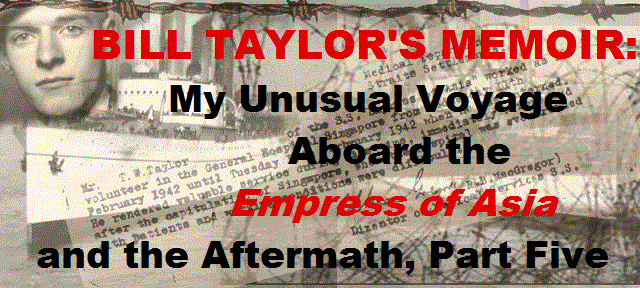|
CHANGI PRISON
We were allotted cells, three men to a cell that normally held one man. I was in B block on the third floor (top floor) with a fellow called
Harper-Ball (Major) and one called
Hoot Gibson. Harper-Ball was a manager
of a rubber plantation and Gibson, who was a very cultured
and gentle man, owned a palm-oil plantation in
Johore Baru.
The cell was about 9 feet by 12 feet with a
concrete block for a bed in the middle.
We tossed a coin for which position we were to use.
Gibson won the block in the middle and we slept either side.
The European wardens managed to take over the kitchen
and slept in the cells above a smart move on their part.
I envied their luck, as nearer to food more chance of survival.
|
Changi Interior After Liberation
|
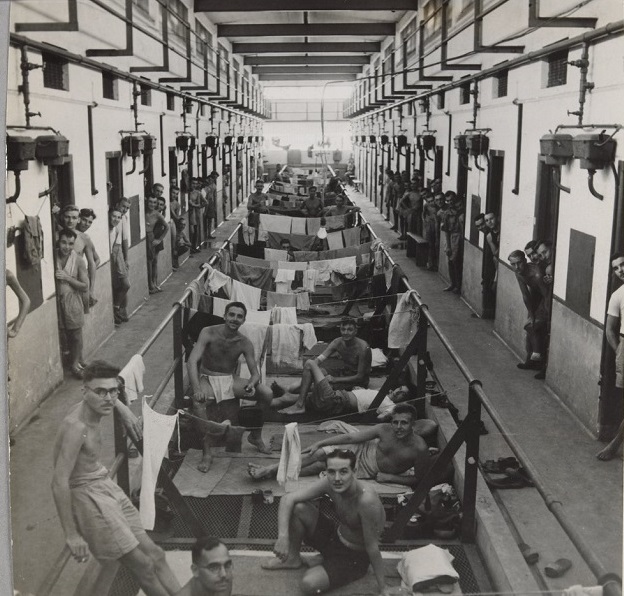
|
|
This photo taken in 1945 after Liberation, is from the
State Library of Victoria, Australia. It is part of the Argus Newspaper Photograph Collection . (Image H98.103/3942).
|
We managed to settle in and get organized. At first
the old colonials thought they still had their servants
etc. and tried to treat the boys as such. However
the Japs gave the order, no work - no food,
so they had to change very quickly. As there were
quite a few who could only do light work or none at
all, we agreed to pool everything.
Those on the heavy work details, myself, got
slightly more than the others as they needed it.
We were served three meals a day consisting of
breakfast which was rice boiled sloppy like porridge,
nothing in it. Lunch, steamed rice and watery soup made
of anything they could find. Dinner, steamed rice (1 cup)
and maybe sardines (6 - 8 men per little tin) or corned beef
spread to about 8 or more men, hardly filling.
There were many different jobs to do.
The main one gardening to plant tapioca and
sweet potato to add to the rations also anything
that could be made edible. It took very hard work
to break up the soil for planting; the ground was
not meant for cultivation. Also we went out with
homemade wagons (part of old trucks) which took
about 8 men to pull them to collect grass etc.
for compost heaps. We were also sent logging to
cut down trees to work the boilers etc. in the kitchen,
which had been converted from oil.
|
PoWs Hauling Wood with a Broken Down Automobile Chassis
|
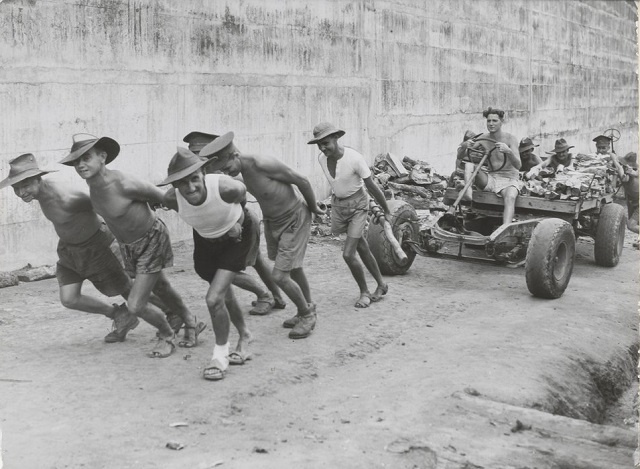
|
|
This photo, dated to around 1945, is from the
State Library of Victoria, Australia. It is part of the Argus Newspaper Photograph Collection . (Image H98.103/3870).
|
|
Prisoners Hauling Wood for the Changi Prison Hospital
|
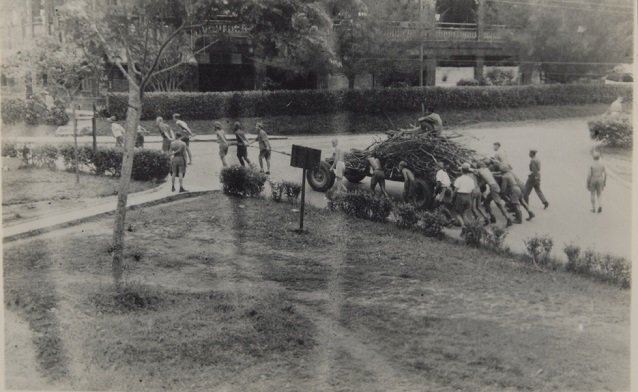
|
|
This photo taken in 1942 is from the
State Library of Victoria, Australia. It is part of the Major Arthur A. Moon Collection. (Image H97.254/9).
|
There were many clever men in the camp who made sandals from old
tyres, as our shoes were worn out. They also made us briefs from old
shirts just to keep us respectable. In the case of
many other things, there was
always somebody who could make it.
On the logging trips the Japs decided we were not allowed to cut
the trees down, but had to dig them out by the roots. As there
were about twenty men all working at the same time on different
trees it was rather dangerous.
One day we were ready to drop a big tree, so we shouted warnings
for everybody to clear the area, then we cut it loose. As it was
dropping we noticed one of the guards had walked into the area
where the tree would fall. Down went the tree on top of him.
I was sure we had killed him--then as the tree settled on the
ground a little head appeared through the branches and we knew he
still lived. He was a bit dirty and in an untidy state and in
a very bad mood, but we found it very funny.
|
Australian ex-PoWs Show Off Their Changi Vegetable Garden
|
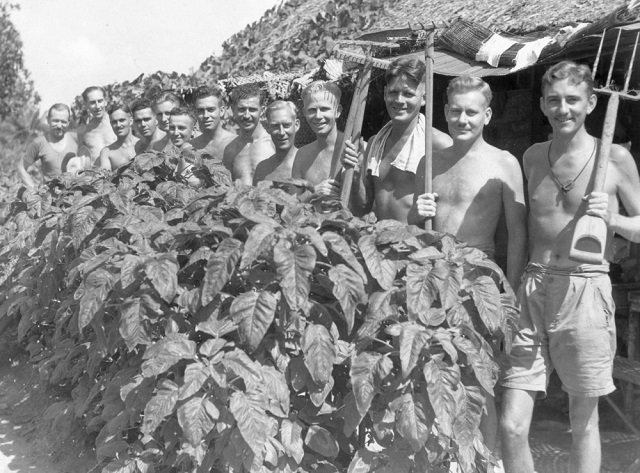
|
|
This photo taken in 1945 after Liberation, is from the
State Library of Victoria, Australia. It is part of the Argus Newspaper Photograph Collection . (Image H98.103/3684).
|
Going on working parties we saw quite a few of
the locals working
their gardens etc., but not being able to speak their language
I could not communicate with them. So I asked
Gibson to teach me to speak
Malay which he was pleased to do.
In a matter of about six weeks I was fairly fluent. I could speak
to the guards who spoke Malay and also some
Sikhs that helped as guards with Japs.
When the Japs were not looking I could speak to the locals who gave
me information and sometimes hid fruit for me to pick up and hide.
I also managed to do a few deals for food etc.--small but handy.
We managed to get news of the outside world as some fellows had
smuggled in a couple of radios. One was hidden in a little wooden
stool and another under a manhole cover in the yard.
News was bad.
|
Freed Australians Show Off Two Wireless Sets Which They Kept Hidden for Three Years
|
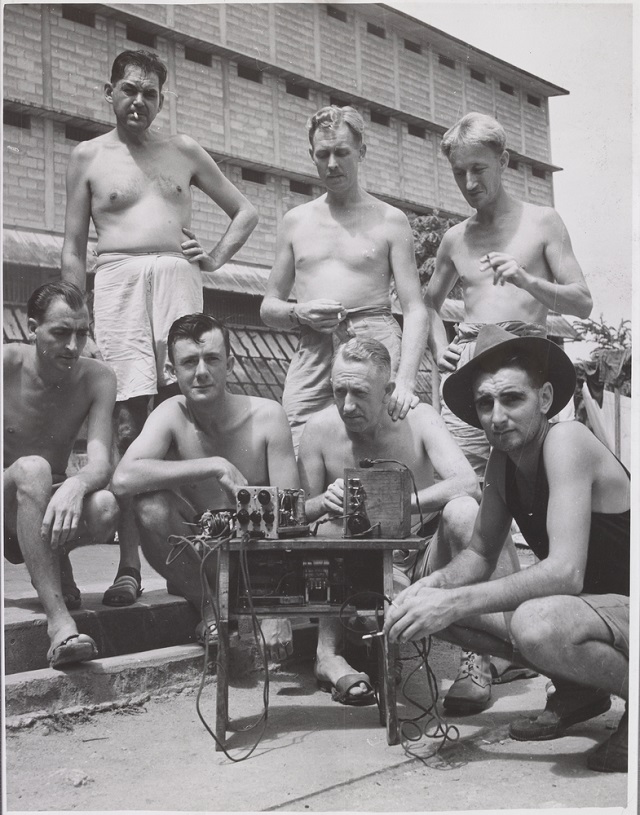
|
|
This photo taken in 1945 after Liberation, is from the
State Library of Victoria, Australia. It is part of the Argus Newspaper Photograph Collection . (Image H98.103/3698).
|
Christmas 1942
came and went. We put on shows for entertainment so
we had some amusement. Being one of the youngest I was asked with a
friend
to play the part of girls, in one show and do the Can-Can as
per the Montmarte.
The woman's camp lent us a couple of skirts and we used two halves
of coconut shells as busts along with a cotton top.
We put turbans on our hair and when you looked at us we looked
like girls. We did out part and were a great success, as we
had a captive audience of over three thousand. We were waiting back
stage when two Jap officers came along and started talking to us.
I explained we spoke a little Malay. They started fussing as it
was obvious they thought we were girls, so we kidded them along and
asked for cigarettes, which they gave each of us a packet.
(English from Red Cross parcels). We said we had to leave but
would come back later. Out of sight we took off laughing our
heads off. At least we had got some cigarettes. We never
received a
Red Cross parcel
all the time I was a captive, but the
Japs were always smoking English cigarettes.
|
Australian PoWs Perform a Concert on Stage in Changi Prison
|
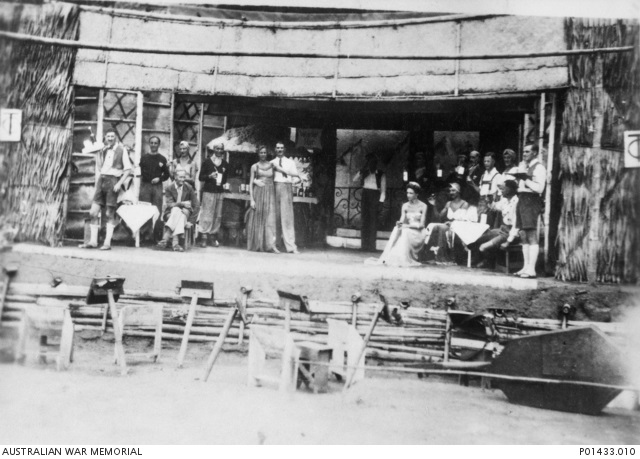
|
|
This photo which was taken circa 1943, is from the
Australian War Memorial website. (ID# P01433.010).
|
Sometimes the guards got drunk and came into the prison slashing
at us with their bayonets and chasing us down the hallways.
Some got hurt if they were not fast enough.
One morning at about five o'clock we were called from out
cells and told to muster in the main yard. When we got there,
there were Japs everywhere, many in civilian clothes. It was not
hard to realize they must be
OGPU, Jap Gestapo.
They started to search the cells and if they found anything
incriminating even a piece of wire or anything suspicious
your name was called and you were interrogated. This went on all
day--we had no food or anything. Finally they finished the search
and took away I understand about 200 prisoners.
I believe they were taken to the
YMCA for interrogation as
that was their headquarters and torture area. They found the
radios and some of the men were executed.
We never saw most of the people they took away, but
about six months later and over a period of time, several fellows
were sent back in coffins. You could see they had been tortured,
but were still alive so we took them to our hospital and fortunately
were able to revive them.
I managed with friends to get
Harper-Ball (my cell mate) elected
camp commandant, so we moved from our cell to a bigger area in
one of the hallways. We were now theoretically "big shots",
and had a chance of more perks. A new
Jap interpreter came to the camp
and used to spend time with us he was very friendly and brought
us food and cigarettes. He spoke with an American accent and
told us he was from Hawaii. He was not happy about the war
and did not believe in it and wished he was home. He was
like us, just wanted to go home. He must have been too
friendly, as he was moved away. We missed his generosity.
Through my new contacts I managed to get a job as rice cook in
the kitchen. I started work at 5:00 am to cook rice in the big
boilers. Rotten job but good for extra food.
|
Liberated PoWs Prepare Rice in Old Bathtub
|
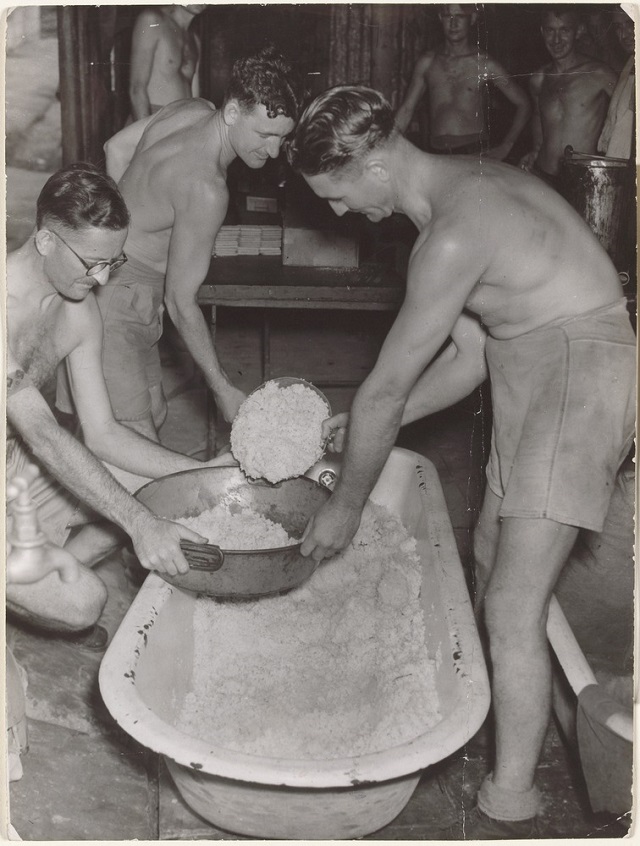
|
|
This photo taken in 1945 after Liberation, is from the
State Library of Victoria, Australia. It is part of the Argus Newspaper Photograph Collection . (Image H98.103/3876).
|
Many more people were being put in the prison with us
from all different places. Captured seamen, Norwegians,
Greeks and a large Jewish contingent from the bazaars.
We had now over five thousand inmates of forty plus
nationalities. Time went slowly at times, but going
on working parties outside the prison helped. Our days
were occupied, and in the evenings we played cards.
I learnt to play bridge and about two months later a
tournament was played. My partner and I entered and it
was really funny when we won.
Many people thought of escaping but although
we could get out of the prison reasonably easy
to get across the straits would be difficult
and then there were thousands of miles of
the worst possible jungle to travel through
and you did not know which natives were
collaborators. There were
spies in the camp and you had to be very careful.
Things were getting tighter in the camp and the Japs
stopped our shows. Constant patrols were checking on
us, when they passed us we had to stand to attention
and bow, if they were not satisfied that you showed
sufficient respect, they would slap you across your
head and you had to continue to bow. Like I
mentioned before being a prisoner was no joke.
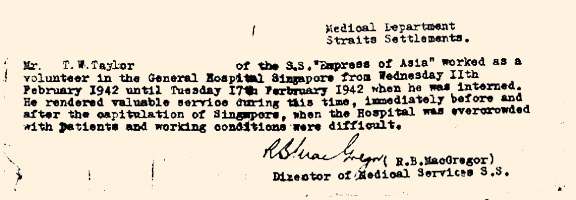
|
|
While in Changi Prison,
Bill was given this document by
the Director of Medical Services for the Straits Settlements.
The Director,
R.B. MacGregor was grateful
to Bill and the other Asia crew members
for their gallant service in the General Hospital during the siege.
This little piece of paper meant a great deal to Bill and
was the only documentation which
Bill ever had giving his whereabouts during the war.
|
It was a regular occurrence for their
Kamikaze pilots to some
round to look at us all dressed in white
with black boots with Japanese writing on them.
One day a batch of high ranking officers came to
tour the camp (I heard one was a Prince). When
they came near us we had to stand to attention
and boss as they passed, one officer was further
back than the group and when he had passed by my pal
muttered "the little yellow bastards". The Jap
stopped and walked back to us and said to my pal
in perfect English "it is lucky we do not speak English".
My pal went deathly white. I am sure he thought
he would be executed, but the Jap walked on laughing.
There are many tales I could tell of the things
we did to get food and the risks we took.
The hardest thing was not knowing how long
our incarceration was going to last.
Our accommodation deteriorated as the prison
became alive with bugs, they were everywhere
in the walls in our clothing the sacks we used
for sleeping on, at night they were all over us
biting away. In one cell we got a blow torch and
burnt over every inch of the walls and ceiling
then we whitewashed it. This we felt would be the cure.
Two days later it was just as infested--we had
wasted our time.
|
Changi Gaol, Singapore by Ronald Searle, 1944
|
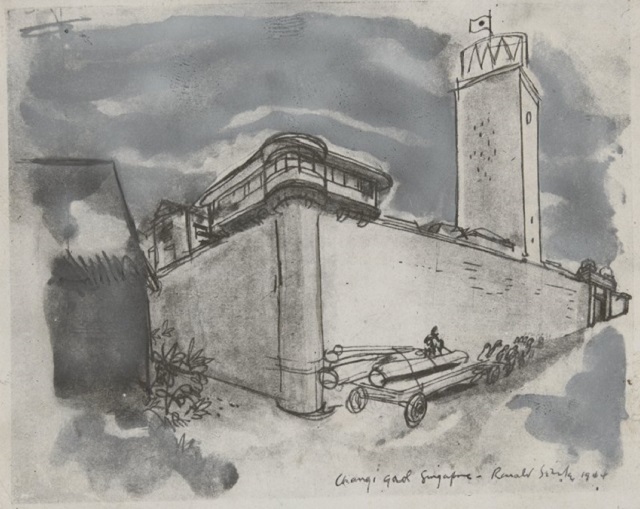
|
|
British cartoonist Ronald Searle (1920-2011) was serving in Singapore with the Royal Engineers when the city fell to the Japanese. He survived four years of brutal treatment as a PoW, including time on the Burma-Siam Death Railway and his incarceration in Changi. This photograph of his original sketch is from the
State Library of Victoria, Australia. It is part of the Argus Newspaper Photograph Collection . (Image H98.103/3957).
|
|
Bill Taylor's Memoir is continued in
Part Six
|
|
